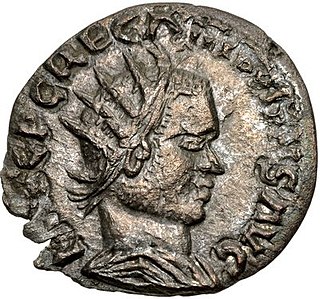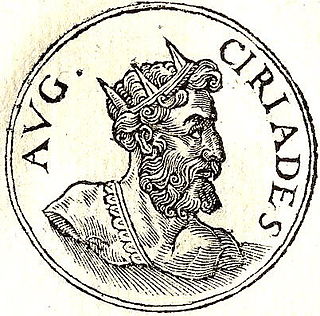
Publius Licinius Egnatius Gallienus was Roman emperor with his father Valerian from 253 to 260 and alone from 260 to 268. He ruled during the Crisis of the Third Century that nearly caused the collapse of the empire. He won numerous military victories against usurpers and Germanic tribes, but was unable to prevent the secession of important provinces. His 15-year reign was the longest in half a century.

Valerian was Roman emperor from 253 to spring 260 AD. Valerian is known as the first Roman emperor to have been taken captive in battle, captured by the Persian emperor Shapur I after the Battle of Edessa, causing shock and instability throughout the Roman Empire. The unprecedented event and the unknown fate of the captured emperor generated a variety of different reactions and "new narratives about the Roman Empire in diverse contexts".

Marcus Cassianius Latinius Postumus was a Roman commander of Batavian origin, who ruled as emperor of the splinter state of the Roman Empire known to modern historians as the Gallic Empire. The Roman army in Gaul threw off its allegiance to Gallienus around the year 260, and Postumus assumed the title and powers of Emperor in the provinces of Gaul, Germania, Britannia, and Hispania. He ruled for the better part of ten years before he was murdered by his own troops.

Marcus Aurelius Marius was emperor of the Gallic Empire in 269 following the assassination of Postumus.

Marcus Piavonius Victorinus was emperor in the Gallic provinces from 268 to 270 or 269 to 271, following the brief reign of Marius. He was murdered by a jealous husband whose wife he had tried to seduce.

Gaius Pius Esuvius Tetricus was the emperor of the Gallic Empire from 271 to 274 AD. He was originally the praeses (governor) of Gallia Aquitania and became emperor after the murder of Emperor Victorinus in 271, with the support of Victorinus's mother, Victoria. During his reign, he faced external pressure from Germanic raiders, who pillaged the eastern and northern parts of his empire, and the Roman Empire, from which the Gallic Empire had seceded. He also faced increasing internal pressure, which led him to declare his son, Tetricus II, caesar in 273 and possibly co-emperor in 274, although this is debated. The Roman emperor Aurelian invaded in 273 or 274, leading to the Battle of Châlons, at which Tetricus surrendered. Whether this capitulation was the result of a secret agreement between Tetricus and Aurelian or necessary after his defeat is debated. Aurelian spared Tetricus, and even made him a senator and corrector (governor) of Lucania et Bruttium. Tetricus died of natural causes a few years after 274.

P. C. Regalianus, also known as Regalian, was Roman usurper for a few months in 260 and/or 261, during the Crisis of the Third Century, a period of intense political instability in the Roman Empire. Regalianus was acclaimed emperor by the troops along the Danube river, a region of the empire that frequently experienced barbarian raids, probably in the hope that he might be able to secure the frontier.

Fulvius Macrianus, also called Macrianus Major, was a Roman usurper. He was one of Valerian's fiscal officers. More precisely, sources refer to him as being in charge of the whole state accounts or, in the language of a later age, as Count of the Treasury and the person in charge of markets and provisions. It seems almost certain that he was an Equestrian. The Historia Augusta claims that he was the foremost of Valerian's military commanders, but that is most likely a gross exaggeration, if not entirely fictitious. He followed Valerian during his ultimately catastrophic campaign against the Persians in 259 or 260; however, he remained at Samosata during the fatal battle of Edessa and his role in the events before and after the battle is questionable. After Valerian's capture by Sassanid Emperor Shapur I, Valerian's son Gallienus became sole emperor, but was occupied with his own problems in the West. Macrianus grabbed the opportunity. With the support of Balista, one of Valerian's military commanders, and with the influence that possession of the treasury of Valerian brought, Macrianus managed to have his two sons Macrianus Minor and Quietus elevated to the throne. He himself was not able to assume the purple because he was deformed in one of his legs.

Titus Fulvius Iunius Macrianus, also known as Macrianus Minor, was a Roman usurper. He was the son of Fulvius Macrianus, also known as Macrianus Major.

Titus Fulvius Junius Quietus was a Roman usurper against Roman Emperor Gallienus.

Lucius Mussius AemilianussignoAegippius who held a number of military and civilian positions during the middle of the third century. He is best known as a Roman usurper during the reign of Gallienus.
The Thirty Tyrants were a series of thirty rulers who appear in the Historia Augusta as having ostensibly been pretenders to the throne of the Roman Empire during the reign of the emperor Gallienus.

Cyriades was a Roman rebel who betrayed the city of Antioch to Shapur I sometime during the 250s. His chief claim to fame is that he is enumerated as one of the Thirty Tyrants who supposedly tried to overthrow the emperor Gallienus.

Publius Licinius Cornelius Valerianus, also known as Valerian II, was the eldest son of Roman Emperor Gallienus and Augusta Cornelia Salonina who was of Greek origin and grandson of the Emperor Valerian who was of a noble and traditional senatorial family.

Valens Thessalonicus was a Roman usurper during the reign of Emperor Gallienus.
The Gallienus usurpers were the usurpers who claimed imperial power during the reign of Gallienus. The existence of usurpers during the Crisis of the Third Century was very common, and the high number of usurpers fought by Gallienus is due to his long rule; fifteen years was a long reign by the standards of the 3rd century Roman Empire.

Lucius Calpurnius Piso Frugi was probably a Roman general whom the imperial pretender Macrianus Major sent to suppress the governor of Achaia, Valens Thessalonicus. His existence is attested only by the unreliable Historia Augusta, which labels Piso as one of several usurpers who plagued the reign of Emperor Gallienus. While some historians grudgingly regard Piso as a historical figure, many reported details of his life, including his usurpation, are dismissed as fabrications.

Publius Licinius Cornelius Saloninus Valerianus, typically just called Saloninus, was a Roman nobleman who briefly became emperor in 260. The grandson of Valerian I, Saloninus was appointed (subordinate) Caesar in 258 in an attempt to shore up the Licinial line of succession during the Crisis of the Third Century. During his time in power, Saloninus administered the German marches out of Cologne. Nevertheless, Saloninus soon became embroiled in a dispute with future Caesar of the Gallic Empire Postumus over war spoils. In 260, Saloninus' troops acclaimed him Emperor in an unsuccessful bid for political legitimacy; Postumus killed Saloninus shortly thereafter.

The Battle of Edessa took place between the armies of the Roman Empire under the command of Emperor Valerian and the Sasanian Empire under Shahanshah Shapur I, in Edessa in 260. The Roman army was defeated and captured in its entirety by the Iranian forces; for the first time, a Roman emperor was taken prisoner.

In the Historia Augusta, Postumus the Younger figures as one of the so-called Thirty Tyrants who usurped power against the Roman Emperor Gallienus. According to the pseudo-historical list of 'Thirty Tyrants', the Emperor of the Gallic Empire Postumus had a son, also called Postumus, whom he nominated to be first caesar, and later even augustus and co-ruler. Postumus the Younger would have been killed together with his father in 268, during the rebellion of Laelianus.


















